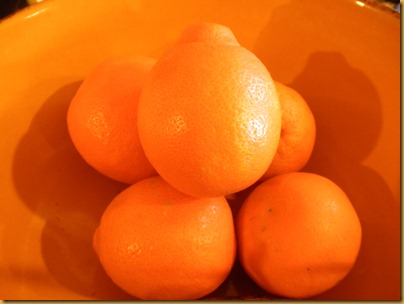I periodically watch the Barefoot Contessa and recently recorded a program from 3 years ago on Italian cooking. This recipe originally came from Florence, Italy and she swore it was her favorite. So I made it and it was delicious but a little too spicy for Paul so I cut the crushed red pepper flakes in half in the recipe below. If you want to warm up your boca a little more just use the ½ teaspoon crushed red peppers originally called for. I also added pancetta at the end for texture and color, buying a package of diced pancetta at Trader Joe’s. However, next time I will buy pancetta at the deli counter, slice it into ¼” strips (lardons) and brown them. I think it would look nicer. Smoked bacon would be good too, I think.
Yes, the recipe calls for penne which will be excellent but Paul and I were 1 block away from the Genova Bakery in Stockton and I took him in there. It’s about 100 years old, in a dicey part of town and well known for their bread. Their foccaccia is divine! When we walked in I was hit by the heavenly aromas of freshly baked bread and aged cheese. They sell pasta making tools and bottled peppers and thingies and I picked up a package of cavatelli from Italy for our dish. (It worked out well.) So use this recipe as a guide, swerving as you may. (I used Manchego because I had it on hand.) It is really delicious. I might use half and half next time instead of cream. Maybe.
Penne Alla Vecchia Bettola
Serves: 4 to 6 servings
Ingredients
- 1/4 cup good olive oil
- 1 medium red onion, chopped
- 3 cloves of garlic, diced
- 1/4 teaspoon crushed red pepper flakes
- 1 1/2 teaspoons dried oregano
- 1 cup vodka
- 2 (28-ounce) cans peeled plum tomatoes
- Kosher salt
- Freshly ground black pepper
- 1 pound penne pasta
- 4 tablespoons fresh oregano
- 3/4 to 1 cup heavy cream
- Grated Parmesan or Manchego or other hard aged cheese
- 4 oz pancetta, cut crosswise ¼” thick, optional
Directions
Preheat oven to 375 degrees F.
Heat the olive oil in a large oven proof saute pan over medium heat, add the onions and garlic and cook for about 5 minutes until translucent. Add the red pepper flakes and dried oregano and cook for 1 minute more. Add the vodka and continue cooking until the mixture is reduced by half.
Meanwhile, drain the tomatoes through a sieve and crush them into the pan with your hands. Add 2 teaspoons salt and a pinch of black pepper. Cover the pan with a tight fitting lid and place it in the oven for 1 1/2 hours. Remove the pan from the oven and let cool for 15 minutes.
While the tomatoes are roasting brown the pancetta strips if using and set aside on a paper towel.
Meanwhile, bring a large pot of salted water to a boil and cook the pasta al dente. Drain and set aside.
Place the tomato mixture in a blender and puree in batches until the sauce is a smooth consistency. Return to the pan.
Reheat the sauce, add 2 tablespoons fresh oregano and enough heavy cream to make the sauce a creamy consistency. Add salt and pepper, to taste, and simmer for 10 minutes. Toss the pasta into the sauce and cook for 2 minutes more. Stir in 1/2 cup Parmesan. Top with pancetta and serve with an additional sprinkle of Parmesan and a sprinkle of fresh oregano on each plate.

I love to tell you about restaurants I’ve tried (the good ones) and Paul and I went away to the Central California Coast this weekend. We started in San Luis Obispo (SLO) and hit the Thursday night farmer’s market. It’s a big social event in SLO and there’s entertainment as well as street food. I had Mamma Mia’s lasagna and it was pretty great street food. We did eat breakfast at the Apple Farm, and it was wonderful. They served a buttery scone that was almost like shortbread with their own boysenberry jam. Yum.

At coffee we ran into some people I knew, and they suggested Giuseppe’s in Pismo Beach for dinner. I was wondering if it was going to be one of those Olive Garden type places, but I was happily wrong. It’s white table cloth with fun décor and a great wine list. I don’t normally drink Syrah but this Syrah made for Giuseppe was smooth, medium on the way to full bodied and delicious. Two glasses and nary a headache later. Huzzah! The osso bucco with saffron risotto was cooked perfectly, I think in white wine. Paul’s bacon wrapped large prawns were slightly overcooked but still delicious. The service was excellent. A little expensive but so worth it. Go to Pismo and eat at Giuseppe’s. It’s on Price St. as is everything else of note in Pismo.

We drifted on up to Cambria, a very pretty town on the ocean with nice shops and galleries and great restaurants. Have breakfast at Linn’s on Main St and try the olallieberrie jam. Dinner at the Black Cat Bistro is pretty important. It’s an old house so the dining is all over the place. They were fully booked but the bar was empty at that moment so there we landed. We have eaten there in the past and I knew good wine was important to them but I was surprised to learn they serve wine in Riedel glasses. They are designed in such a way as to bring out the best in the flavors of the wine. Heck if I know how that works, but it does. Paul and I decided to share some plates and had a risotto, a gnocchi appetizer and a goat cheese plate with a short bread cookie with a couple of jammy things that was delicious. The smoothest chevre I’ve ever had. The wine she was good too. So, yes I recommend the Black Cat. You might want to make reservations. It’s popular.

P.S. if you love succulents there is a wonderful nursery called the Garden Shed in Cambria that sells rare and exotic succulents. A really great selection; Paul and I went gaga. We also bought some plants. We have a new plant addiction for Paul.
We drifted further north to Monterey on the hairpin ride of Hwy 1. I was reminded why it is such a pain to drive but filled with beautiful sights. We returned to the scene of the crime (we ate there a year ago) at Esteban, a mediterranean/tapas restaurant in the Casa Munras hotel. I wanted to try the bacalao, salt cod mixed with mashed potatoes. It’s fishy, but I decided I liked it without the bread, as did Paul. The lamb burgers were juicy, the pickled onions added a nice brightness to contrast the lamb. The butter lettuce salad with blue cheese and candied pecans was nice and fresh and delicious. Our server Ernesto was very helpful and friendly. And yes, the wine was good.
Wild Plum café is a block away and a great place to have breakfast. They really know how to cook breakfast potatoes – actually cooked through and well seasoned. I had a wonderful frittata with feta and other delights. Their bread and pastries are house made.
One last place to stop: we had agreed to stop in at Andy’s Orchard in Morgan Hill on the way home. I had read about it in Sunset Magazine, mooning over the apricots picked ripe instead of green, the wonderful cherries. You get my drift. Well his little country store had extremely sweet and delicious Rainier cherries and the apricots I brought home are juicy and flavorful. I will be sad when we have eaten them all, as you would be.













